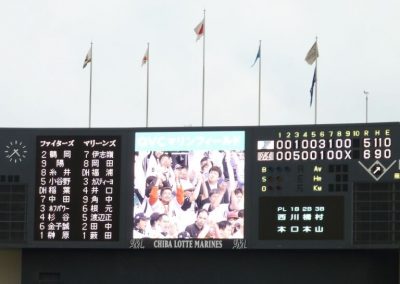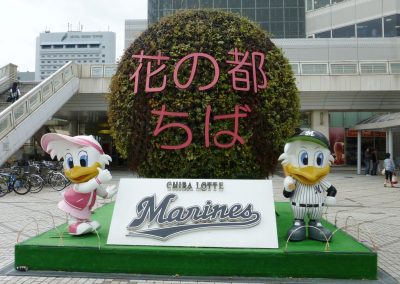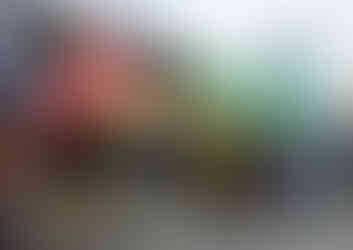ZoZo Marine Stadium - Chiba Lotte Marines
- Sean MacDonald
- May 12, 2011
- 6 min read
Updated: Mar 11, 2023
Photos by Sean MacDonald, Stadium Journey
Stadium Info FANFARE Score: 2.86
ZoZo Marine Stadium 1 Mihama Mihama-ku, Chiba 261-0022, Japan
Year Opened: 1990 Capacity: 30,000
Quality, Value, Chiba!
In 1990, Chiba Marine Stadium was built on the shores of Tokyo Bay and two years later, the Lotte Orions moved there and became the Chiba Lotte Marines. It didn’t take long for people to realize that building an outdoor stadium next to a large body of water isn’t always the best idea, as the ballpark became famous for its difficult playing conditions whenever the weather turned slightly foul. Swirling winds and bone-chilling temperatures are the norm early in the season and night games sometimes require an extra layer or two of clothing, even in midsummer.
In 2011, shopping channel QVC bought the naming rights and the stadium was known as QVC Marine Field. Along with the name change came a newly installed turf and what seem to be some other cleanup projects as the stadium was brighter and more colorful than I had remembered.
It is now known as ZoZo Marine Stadium.
Food & Beverage 3
As with all Japanese ballparks, you should investigate your dining options before entering. I found a number of interesting stalls, including gyutan tsukune (minced beef tongue on a stick) and sausage and steak tacos. Take your time to explore here and remember that any food you buy can be brought into the stadium. There is also a small picnic area here where you can sit to enjoy your meal.
Once inside, the first floor is lined with concessions that offer typical Japanese fare. There’s also a Domino’s (600 yen for a slice of cheese-filled pizza) and Nakau, a fast-food chain that offers udon and donburi and was the most popular stand. My favourite was the honey peanuts from Rie Coffee, a bargain at 250 yen and great for snacking throughout the game. Note that the 2nd floor has limited concessions, so you are better off buying what you want on the 1st floor before walking up.
Beer here is served in smaller cups and is consequently a bit cheaper than in the other ballparks. You can also buy cups of shochu, a clear, distilled beverage that comes from wheat, rice, or potatoes for the most part. It is stronger than wine but the distinct taste is one worth trying.
For those looking to enjoy a real meal after a day game, try Tony Roma’s on the third floor in the Marive Dining building. Across the street in the Plena complex is the Marines Official Sports Bar, a small outpost that just shows highlights of Chiba games and seems to serve more as a smoking area rather than a full-on drinking spot. There are several other restaurants around here, but nothing that you can’t find at any typical large train station in the greater Tokyo area.
Atmosphere 3
The stadium seats only 30,000 but with two seating levels and a relatively roomy upper deck, the atmosphere is not as good as it could be. The upper level is mostly unreserved seating, so fans generally try to spread themselves out. Fortunately the outfield seats are jam packed and it is these cheering groups that keep the stadium alive, particularly when the Marines are enjoying a long rally.
As an open air stadium next to the bay, the air is fresh and cool. The sun moves from left field to right during a day game, so you can always find shade if you are looking for it. I found this to be a relaxing and comfortable place to watch the game.
Neighborhood 2
The stadium is surrounded by nothing except office buildings and exhibition halls. Only Kaihin Makuhari station provides any entertainment or food options, and even those are fairly limited and uninteresting. My recommendation is to take the train back to Tokyo or over to Chiba to find a more dynamic environment post-game.
Fans 4
Lotte fans are infamous in Japan for being tough on their team, but they might also be the most united. The outfield stands are completely white as every fan seems to be wearing a Marines uniform and the energy they showed by jumping up and down throughout the game was fantastic. Even after the game the entire group stayed and continued to cheer as their team had prevailed.
The Marines faithful are also famous for their support of one-time manager Bobby Valentine, who spent seven seasons with the club and led them to the Nippon Series title in 2005. When the club announced that they would not retain his services after the 2009 season, thousands of fans signed petitions, wore “Bobby 2010” t-shirts, and waved large signs, all in an ultimately vain attempt to force the team to reconsider. Ironically, the first season after Valentine left, the Marines again won the Nippon Series, this time after finishing third in the regular season but using a strong rotation to win the Pacific League’s Climax Series before besting Chunichi in the final.
Access 2
The closest station to QVC Marine Field is Kaihin-Makuhari on the Keiyo Line. It’s about a 40 minute train ride from Tokyo, but then another 15-20 minutes to walk to the stadium itself. Bus service is available from the station for a meager 100 yen, although I prefer to walk; most of the way is via elevated pedestrian walkways.
I’m docking points here for a number of reasons. The concourses are narrow and not easy to navigate when crowded. When you go up to the second level, you have to walk through a smoking area, in fact the stadium is filled with them and they should really be moved outside of the concourses. The toilets are limited and you can see right into them, a curious but not uncommon situation in Japan. Even the ladies’ loo was sporting a urinal for some strange reason. Finally, there are far too many checkpoints and you can’t move around the stadium on the lower level before the game without showing your ticket. These minor annoyances, coupled with the distance from the stadium, are why I am giving QVC Marine Field an access rating of just two stars.
Return on Investment 3
Tickets here are priced fairly, but be careful of the field level seats, which are on the field but stretch well down the lines, almost to the corners, which seems to be a terrible vantage point.
The best option is the second deck unreserved seats at 2,300 yen ($30).You can sit pretty much anywhere in the upper deck, and when the stadium is not full, you can usually get a few seats to yourself.
One of the interesting things about QVC Marine Field is the colorful seats. Each section is color-coded in the same way as on the stadium seating map. Red, green, orange, and light and dark blue seats remind you where you are but also provide a welcome alternative to the usual monochrome seating plans.
For parents with toddlers, there is a small play area on the concourse which might help pass the time.
In other areas, there are not a lot of bells and whistles here. A ribbon board is on the facing of the upper deck and shows the batter’s previous results, while the scoreboard is typically large but provides little more than lineups and the linescore. I do like the wind direction indicator on the right side of scoreboard. It didn’t show higher than 3 m/s at the game I attended, but in the spring and fall, you might see it hit double digits. Another interesting feature is that the batting average and home run stats change immediately after the play, before the next batter is announced.
As Lotte is a gum and candy maker, all fans are handed a pack of lemon gum as they enter the stadium.
Extras 3
The Marines Museum was a nice surprise as it was not here on my last visit. It is a small Hall of Fame dedicated to the franchise, which has moved around quite a bit. Located just across from the main entrance, the museum is free and only takes a few minutes to explore, but there is a lot of history here. Do take the time to walk through it.
The Marine Dance Academy seems to be a cheerleading school that has dozens of dancers from age 4 and up. They were on the field before, during, and after the game. As well, they have a stage outside where the actual team cheerleaders put on pre-game performances that attract mostly guys with zoom lenses.
Finally, the day I went was Drug Store Day and they were handing out travel size shampoo and other sundries before the game. It was amazing how long the lineups were for something worth perhaps 50 yen, but in these trying times, every little bit helps.
Final Thoughts
I was surprised at how much I enjoyed my time here. On a previous visit, the weather was miserable and cold and I hated it, but for an afternoon game, the stadium is pleasant, spacious, colorful , and loud. The friendly staff and few extras mentioned make QVC Marine Field well worth a look if you are in Tokyo or Chiba during the baseball season.








Comments